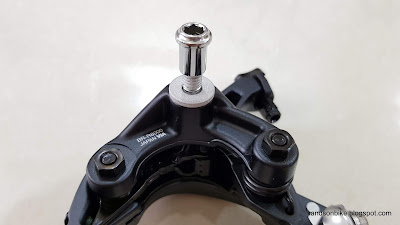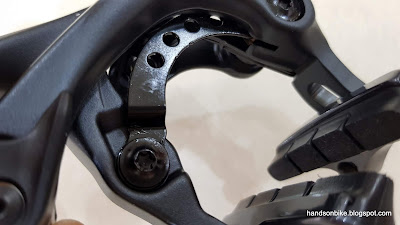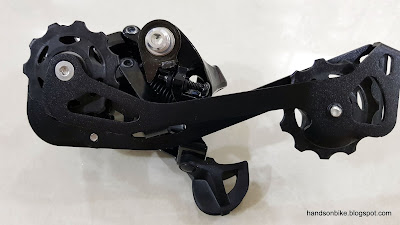Are you riding a mountain bike? What drivetrain do you use on your mountain bike? In recent years, the mountain bike drivetrain has undergone a huge shift, from the traditional front triple system, to the front double system and finally to the front single system.
Last time, a front triple was necessary, because the rear cassette had a relatively narrow range (11-34T was considered large at that time), and limited number of speeds (8 or 9 speeds). A front triple was necessary to get the range required.
When 10 speed drivetrains appeared, it also came with wider range cassettes such as 11-36T. This enabled a front double system to achieve a similar gear range as traditional front triple systems.
After that, 11 speed MTB drivetrains were created by SRAM, which had a massive cassette range of 10-42T, which is a 420% range just from the cassette alone. That meant a front single drivetrain is usually sufficient, except for really low gears or really high gears. If you really want a 2x11 speed drivetrain, Shimano still has it for those who need the wider range.
Now, 12 speed drivetrains are becoming more popular, although the prices are still not so affordable yet. With 12 speeds on the cassette, a front single drivetrain can give you all the range you need for off road riding and also on road riding. Although the gear steps are still big, it is acceptable for off road riding where your cadence varies all the time anyway.
For the SRAM 11 and 12 speed cassettes, a special XD driver is needed on the rear hub, as the smallest sprocket is 10 teeth, which is too small to fit on a traditional 9 spline freehub body. This was an issue that slowed the adoption of SRAM's 11 and 12 speed cassettes.
XD Driver which was created by SRAM. The cassette is engaged to the splines only at the base, while the threads are used to tighten the cassette to the free hub body.
On the other hand, Shimano's 11 speed cassettes still used the common 9 spline freehub body, which is the same as those used for 8/9/10 speed cassettes. This means that a straight cassette swap on the same rear wheel is possible, although you still need to upgrade the other components such as shifter, rear derailleur and chain to 11 speeds. The downside to this is that the smallest sprocket is limited to 11 teeth, which means lesser range than SRAM's 10 teeth sprocket.
As mentioned earlier, a major stumbling block to mass adoption of wide range cassettes with 10T sprockets is the requirement for an XD driver. Many people are still using the traditional 9 spline freehub body and are reluctant to change the rear wheel. Unless you are getting a whole new bike with XD driver on the rear wheel, it is usually not cost effective to change the rear wheel as the old frame is probably not compatible anyway. For occasional off road riders like myself, I don't want to invest in a whole new mountain bike, but I still want to upgrade to more speeds.
So, if you are willing to give up the 10T sprocket, and settle for an 11T sprocket (and lesser range), it is possible to upgrade your drivetrain without changing your rear hub!
SRAM's Eagle cassette has a massive range of 10-50T, which is a huge range of 500%, and it is as big as a road chain ring. If you are willing to sacrifice a bit of range, and go for a 11-50T cassette, it can conceivably be installed on a normal 9 spline freehub body.
Although there are 11 or 12 speeds, the largest sprockets are suspended over the hub, as there is still space due to the dishing of the wheel and the spoke angle.
I came across this budget S-Ride 12 speed groupset, or more accurately, an upgrade kit. An upgrade kit does not have the crankset which you probably already have on your bike anyway.
With an affordable price of about $300, you can get a 1x12 speed drivetrain upgrade kit, which is a good way to try and see if you like the 12 speed setup or not.
Starting with the 11-50T 12 speed cassette, let's take a look at these components!
Massive 11-50T 12 speed cassette! Brand is Sunshine, which I have never heard of. Seems to be part of the S-Ride brand?
Only the two smallest sprockets (11T and 13T) are loose, the other 10 sprockets are riveted to each other or the aluminium spider.
Instead of using a lightweight (but expensive) one piece construction like SRAM's hollow cassettes, this cassette is made of stamped steel sprockets riveted together.
Sprocket sizes shown here (13-15-17-19-21). 11T not shown.
Continued (24-28-32-36-42-50), the gear steps are pretty big but OK for off road riding. Using some odd numbered gears might give a better gear step, but even numbered sprockets generally can provide better shifting performance.
Eye-catching red aluminium spider at the back!
The 4 largest sprockets (32-36-42-50) are riveted to this spider. The last 2 sprockets are also offset to be suspended behind the freehub body.
Another view of the spider and how it connects to the sprockets
For size comparison, this 11-50T cassette is almost as big as the Dura-Ace 53T road chain ring!
Due to the many sprockets and lower cost stamped steel construction, this cassette weighs 596 grams which is heavy.
The highlight and most important part of this groupset is undoubtedly the gigantic 11-50T cassette. Let's see what the other components are.
12 speed chain, comes with a set of quick links!
This chain is made by YBN which is a big chain manufacturer. No worries about quality here.
Weighs 260 grams with the plastic packaging and before cutting to length.
As for the rear derailleur, it needs to cater for the 11-50T range of the cassette, both in terms of chain capacity and also the parallelogram angle. Curiously enough, this S-Ride rear derailleur comes with a choice of clutch and non-clutch versions. For off road riding, a clutch version is definitely better as it stabilizes the chain to prevent chain drop.
S-Ride rear derailleur for 12 speed, with clutch. The "C" behind the model number RD-M500 signifies the clutch version. Other than that, there is no other obvious way to tell if it is a clutch version or not. No clutch adjustment is possible.
This rear derailleur construction is the traditional road type, not the Shadow type of mountain bike rear derailleur which has a lower profile to avoid damage.
Outer casing stopper located here, which is quite similar to SRAM's design.
When in the top gear position, the rear derailleur sticks out quite a bit as can be seen here. More prone to damage if you ride near rocks. Also note the steep parallelogram angle, which is needed to reach the large 50T sprocket.
High and Low limit screws are located on the outer link of the rear derailleur.
Resin cable guide to route the inner cable towards the cable fixing bolt.
Long cage is necessary to take up the chain slack across the large 11-50T cassette.
Weighs 265 grams, which is surprisingly light weight, as it is similar in weight to the Deore XT M8000 rear derailleur.
Finally, the 12 speed shifter, to move the rear derailleur across the 12 gears on the cassette. This is the contact point between the rider and the drivetrain, so it is important to get the shifter right.
S-Ride 12 speed shifter, looking like a blend between Shimano and SRAM shifters.
12 Speed feature indicated boldly on the cover
Comes with a gear display, which I personally like. Although it is not necessary when riding in the trail, it is nice to have a reference from time to time, as I tend to get lost in the multiple gears.
The unique lever which allows push or pull release action. Works differently from Shimano's 2-way release design.
Bottom view looks totally like a SRAM shifter. Shift levers are steel plates encapsulated in plastic.
After removing the covers, here is how the release lever works. It pivots around the centre when you push or pull the release lever, which engages another plate to release the gear.
One interesting thing about the clamp band is that the mechanism is only secured to the clamp band when you tighten it on a handlebar. Otherwise it is just floating...
Shifting feeling wise, it is not the best, as it feels rather plasticky, much like most of SRAM's shifters. The release lever also rattles, as there is no additional spring to take up the play. Otherwise, shifting function is OK.
Shifter weighs a competitive 108 grams, which is mainly due to the use of plastic parts which are lightweight and also cheaper than aluminium parts.
View of the upgrade kit! Looks pretty decent.
The quality of the components are quite OK, but it will finally depend on the shifting performance when mounted on the bike. The most important thing is that it fits on a normal (outdated?) mountain bike, which is my
Polygon Cozmic CX3.0. Although I don't ride it often, this new 12 speed groupset gives me the chance to ride and test out the S-Ride components.
In another post, I will show the components mounted on the mountain bike, along with a few other new parts!




























































